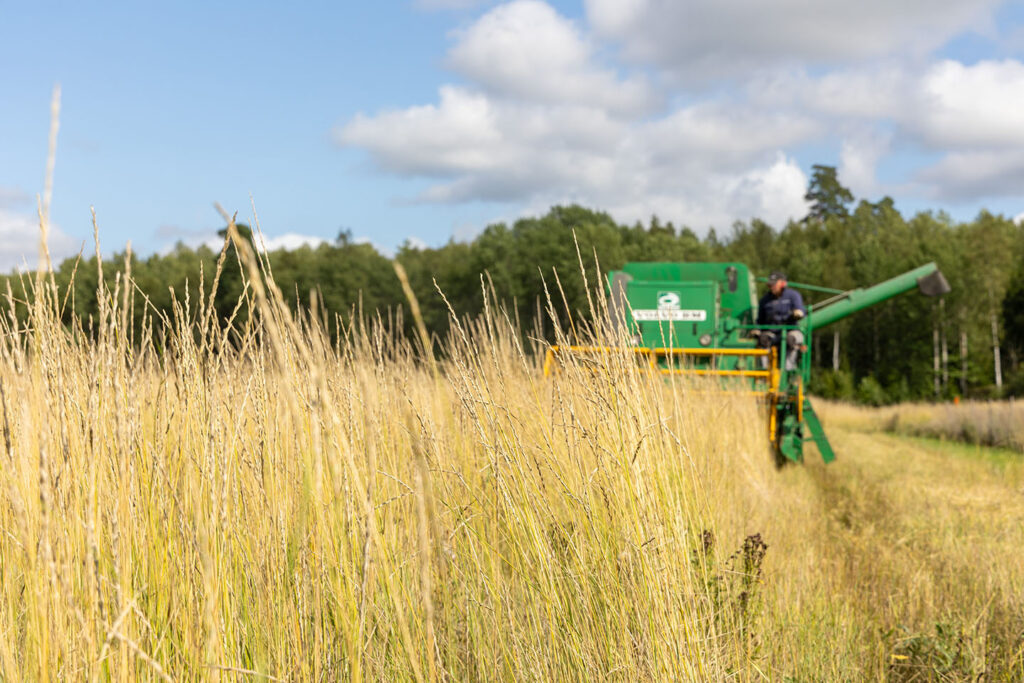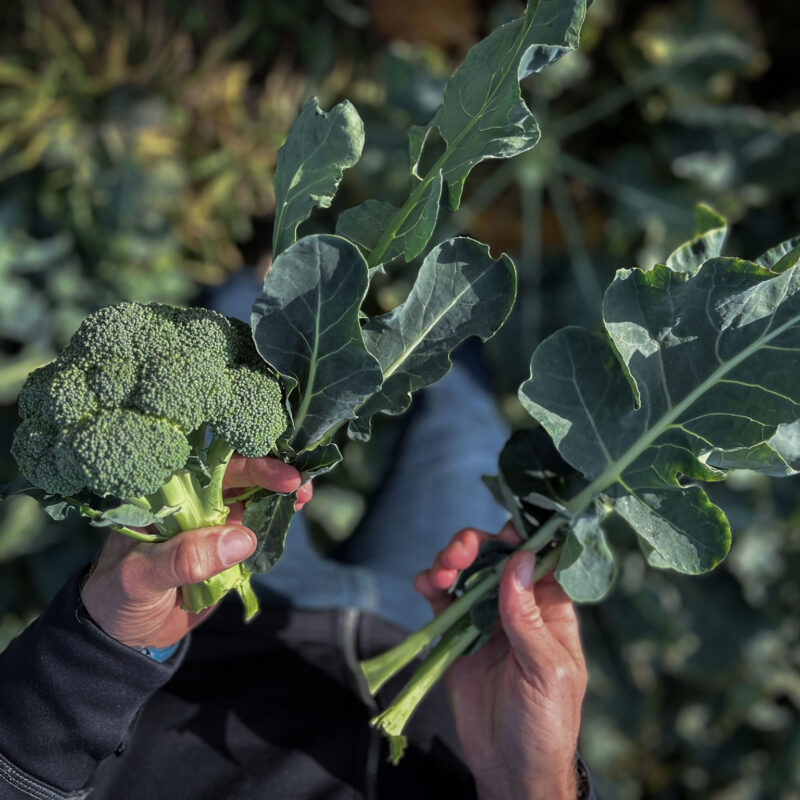What Exactly is Sustainable Agriculture?
2024.03.22

Maria Lundesjö is a Food Agronomist with a PhD in Food Science from the Swedish University of Agricultural Sciences (SLU) She is also a Project Manager within Future Food at Axfoundation.
Maria Lundesjö’s Sustainability Insights: One thing is certain: To feed the world’s growing population without risking catastrophic environmental consequences, we must change the way we produce our food. Period. But how? When sustainable agriculture takes center stage, a variety of terms describing cultivation methods are thrown around; organic, conventional, regenerative, conservation agriculture… The list goes on. But what do they really mean? What are the pros and cons? Are they truly distinct, or are there common denominators? And is one superior? Hold on tight. We’re about to clarify these concepts!
Let’s start where Axfoundation always starts. In the problem statement and the question of why: Why is sustainable agriculture important?
Well, because the transition to sustainable agriculture is fundamental. Inevitable. And vital. Because the challenges within global agriculture are monumental. Agricultural land occupies about 40% of the Earth’s land area (the majority is used for feed). The food sector accounts for nearly a third of global greenhouse gas emissions, 75-80% of biodiversity loss, 70% of freshwater usage, and nearly 100% of the impact on biogeochemical flows (nitrogen and phosphorus). Moreover, of all that we produce, as much as one-third goes to waste. One-third. That’s an immense amount.
The transition to sustainable agriculture is fundamental. Inevitable. And vital.
At the same time, agriculture itself is, of course, fundamental. Inevitable. And vital. As is well known – one must eat, otherwise one dies. However it’s also vital as agriculture is linked to the conservation of biodiversity and ecosystem services, such as pollination and water regulation, which are crucial for a sustainable ecosystem and human well-being. It can also sequester carbon in the soil through plant photosynthesis; the less the soil is disturbed, the greater the potential to sequester the carbon dioxide. And, of course, agriculture is an economic engine that creates employment and generates income.

Agricultural land occupies about 40% of the Earth's land area.
What is agriculture?
AGRICULTURE. The science or practice of farming, including cultivation of the soil for the growing of crops and the rearing of animals to provide food, wool, and other products.
In general use: cultivation or farming of land. (Lat.) Agitatio terræ.
Agriculture, in essence, is a human activity and can be described as a collection of methods and techniques used in fields and pastures for cultivating land and producing food, feed, fiber, and other useful products.
It typically involves various phases, including land preparation, seeding and planting, crop management, harvesting, and often animal husbandry.
The goal of agriculture is to ensure a stable and sustainable supply of food and other products to meet human needs.
What is the common ground in sustainable agriculture?
Sustainable agriculture encompasses a range of concepts and methods. What they all have in common is that they aim to reduce the negative environmental impact of agriculture. This can involve reducing the need for artificial inputs, conserving natural resources, combating reduced productivity, ensuring economic viability, and promoting social justice. Some of the most common concepts include:
- Conventional agriculture
- Organic agriculture
- Agroecological agriculture
- Conservation agriculture
- Regenerative agriculture
- Agroforestry
- Precision agriculture
It’s important to distinguish between the science of ecology and value-laden concepts like organic.
It’s important to think carefully when using these concepts, and it’s crucial to distinguish between the science of ecology and value-laden concepts such as ecological (organic). Ecology is the science that deals with the interaction between organisms and the environment they live in. Ecosystem services are the products and services that natural ecosystems provide to humans, contributing to our well-being and quality of life. Ecological (organic), on the other hand, is a farming method with established rules and certification bodies that oversee compliance. Let’s go through them in a brief primer.
Agriculture Glossary
How do different agricultural terms and cultivation methods relate? And how do they differ from each other?
Conventional Agriculture – business as usual
Conventional agriculture is the most common form of cultivation today. The term is used when no specific principles govern cultivation methods. It is permissible to use mineral fertilizers to add nutrients, and chemical pesticides to limit damage from insects, diseases, and weeds can be used. In conventional agriculture, the lack of developed ecosystem services can be replaced with chemical pesticides and mineral fertilizers.
Organic Agriculture – viewing agriculture as an ecosystem
Organic agriculture primarily aims to manage agriculture as an ecosystem rather than relying on external inputs like mineral fertilizers and chemical pesticides. This often makes agriculture more dependent on mechanical cultivation to control weeds. Organic agriculture has regulations and certification bodies that monitor compliance with these rules.
Agroecological Agriculture – combining ecological, economic, and social sustainability
Agroecological agriculture encompasses ecological, economic, and social sustainability throughout the food system. Several principles within agroecological agriculture overlap with organic agriculture, but there is currently no established regulatory framework or certification body.
Farmers employ a range of cultivation principles, including having a favorable and diverse crop rotation, using fertilizers and pesticides efficiently, minimal or no soil tillage, and using beneficial cover crops (e.g., legumes that fix nitrogen, making them available as nutrients for future crops). The goal is for the ecosystem services that arise from these principles to replace fossil-based inputs like mineral fertilizers and pesticides.
Conservation Agriculture – minimal soil disturbance, ground cover, and diversity
Conservation Agriculture is a concept from the American Midwest, where the method was developed to address problems of drought and soil erosion. It is based on three principles: minimal soil disturbance, continuous ground cover, and diversity in cultivation (varied crop rotation with different crops).
The FAO adopted the concept of Conservation Agriculture as early as 2001 and has since 2017 used the definition with the three principles. In Sweden, conservation agriculture, in practice, often depends on the use of herbicides in the form of glyphosate to control weeds and terminate cover crops, which risks significant negative environmental impact.
Regenerative Farming – integrating animal husbandry and crop cultivation
Regenerative farming developed in the USA from the idea of harnessing the natural tendencies of ecosystems to recover when disturbed. Although this method is rooted in ecological principles, it can be applied across all forms of cultivation today. However, a clear definition is lacking both in Sweden and internationally, leading to the term being used in many areas and risking dilution.
The goals of regenerative farming are increased biodiversity, improved soil health, increased carbon sequestration, and increased water and ecosystem health, but the methods to achieve these goals are not clearly defined. It largely involves integrating animal husbandry and crop cultivation, minimizing the use of external inputs like fertilizers and pesticides, minimizing soil tillage, varying crop rotations, and using green manure.
Agroforestry – silvopastoral systems with trees and shrubs
Agroforestry, or silvopastoral systems, are cultivation systems where woody perennial plants like trees and shrubs are integrated into crop and livestock production. This can include alley cropping with rows of trees on open farmland, forest gardens, and woodland cultivation.
The method is used to a limited extent in Sweden today, but there is great interest in the future, especially since it creates environments more diverse than today’s agricultural landscapes and promotes greater biodiversity. Agroforestry also contributes to carbon sequestration, reduced soil erosion, and increased resilience to flooding, much like other sustainable cultivation methods.
Precision Agriculture – efficient cultivation with technology
Precision agriculture uses technology to enable more efficient cultivation, regardless of the form of cultivation. Sensors are used to measure the field’s needs for fertilizers and pesticides, and a specific dose can be distributed for each part of a field, thereby minimizing unnecessary use.
Want to know more? The Ekofakta website (in Swedish), run by SLU, has compiled the most important information you need to know about everything from organic farming to agroforestry. Perfect for those who want to delve a little deeper.
What separates the terms – and what unites them?
Several of the cultivation methods presented in the glossary are difficult to distinguish because they overlap to varying degrees. For instance, regenerative farming has evolved from organic farming, but today it can encompass both conventional and organic cultivation. This issue is further exacerbated by the presence of numerous and sometimes unclear definitions and applications of these cultivation methods.
There are also many shared viewpoints among the terms, such as the ambition for cultivation to rely as much as possible on ecological processes rather than external inputs. However, which cultivation approach best fulfills this ambition is unclear. Nevertheless, since organic farming prohibits the use of multiple types of inputs such as mineral fertilizers and pesticides, it significantly restricts their use within that cultivation method.
The differences between the various cultivation methods often lie in varying prioritizations of common principles.
Instead, the distinctions between the different cultivation methods often arise from varying prioritizations of common principles. For example, in Conservation Agriculture, the principle of minimal soil disturbance is often valued more highly than the principle of minimizing the use of pesticides, whereas the opposite is true in organic farming. Another example is regenerative farming and Conservation Agriculture, which share a central focus on soil as fundamental to sustainable cultivation but with a distinct emphasis – regenerative farming places greater importance on soil biology, while conservation agriculture focuses on its physical properties. A third example is Agroecology and Organic Agriculture, both of which clearly emphasize social aspects such as justice and health as important integrated components for sustainable cultivation, which few other cultivation methods do.

At Torsåker Farm, Axfoundation collaborates with researchers and farmers in various initiatives, with one common goal: A transformative change in agriculture leading to sustainable food systems.
Which method is best – and what does Axfoundation do?
So – which method should be used? Well. Here, research, opinions, and various interests diverge. Axfoundation’s ambition is to scientifically examine differences in effectiveness with the help of researchers in different fields, rather than giving them a specific name. For example, which methods contribute to increased carbon sequestration and improved soil fertility?
Therefore, at Torsåker Farm, Axfoundation collaborates with researchers and farmers in various initiatives where we collectively evaluate agroecological methods for increased biodiversity and methods for improved soil health and carbon sequestration. Torsåker Farm is also a place where cutting-edge researchers develop new perennial crops like perennial wheat and perennial barley and test existing crops like hemp. The common goal for all projects? A transformative change in agriculture leading to sustainable food systems.
It’s not about using the right term or adhering to the correct principle one hundred percent. It’s about choosing what yields the best results from farm to farm and starting now. If many make small adjustments, significant effects can be achieved. And what we can all agree on is that the transition to sustainable agriculture is fundamental. Inevitable. And essential for life.
/Maria Lundesjö, Project Manager within Future Food at Axfoundation




































